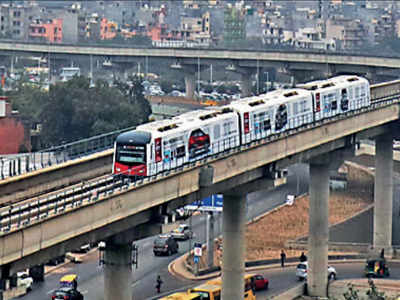IAS officer Ashok Khemka writes to CM Khattar, seeks probe by CBI or ED
The daily ridership numbers of the Gurgaon Rapid Metro is not even 10 per cent of the figure projected while conceptualising it, an official report has shown leading a senior IAS officer in Haryana to demand a probe in the entire manner in which the project was planned and implemented.
Documents reveal that from October 23, 2019 till March 21, 2020, the Rapid Metro’s 11.7-km line operated for 151 days with a total ridership figure of 76,41,367. After that the Metro stopped operating due to Covid-19 lockdown restrictions. The Metro restarted operations from September 7, 2020 and till March 31, 2021 – for 206 days – it garnered a total ridership of 16,08,005. The total ridership figures for this 357-days period was 92,49,372.
The “Statement and Revenue Expenditure of Rapid Metro (Gurugram)” further reveals that the total deficit for the period – October 23, 2019 till March 31, 2020 – was Rs. 3.87 crore and for the period April 1, 2020 till March w31, 2021, it was Rs. 37.81 crore. The deficit does not include the cost of capital.
Senior IAS officer Ashok Khemka, who in 2019 had flagged the project as “a classic example of crony capitalism”, has now shot off a letter to Chief Minister Manohar Lal Khattar demanding that a CBI probe be conducted in the entire manner by way of which Rapid Metro project was conceptualised and implemented.
In his letter, Khemka pointed out that the Rapid MetroRail Gurgaon Limited (RMGL) and the Rapid MetroRail Gurgaon South Limited (RMGSL) – the two special purpose vehicles (SPVs) floated by the Infrastructure Leasing & Financial Services and DLF group promoted firms for the project – utilised Rs 3,800 crore for the 11.7 km line before operations were taken over by Haryana government. “The amount is in effect bank credit and will be borne either by the banks or the state government. Haryana Shahri Vikas Pradhikaran (formerly known as HUDA) has already deposited Rs 1,925 crore into an escrow account and the dispute is presently under arbitration. If the arbitration award goes in favour of the concessionaire, that is, the termination is held to arise due to HSVP default, the liability of the HSVP shall be Rs 4,000 crore and above,” read Khemka’s letter to Khattar.
Khemka blamed low ridership figures for Rapid Metro’s operational losses. “The Detailed Project Reports projected a daily ridership of 3.72 lakh for RMGL and 2.67 lakh for RMGSL by the year 2020. The actual ridership is less than 10 per cent of the fictional figures projected in the DPRs. The ridership figures in DPRs were fudged to obtain permission for right of way and bank credit. This is a classic corporate fraud and a few officers of the state and HUDA were willing accomplices to the crime,” the senior IAS officer said, adding that “such transactions benefitting corporates get re-paid with sweetheart deals”.
Demanding a thorough probe into the matter by an independent investigating agency, Khemka added, “A private infrastructure was built and now operated at public cost. The crime of corruption and fraud should be handed over the CBI or ED for investigation and losses recouped from the guilty”.
The Gurugram Rapid Metro was announced with a lot of fanfare as a free Metro infrastructure project in the PPP mode. On becoming insolvent and following a request from Haryana government, the Delhi Metro Rail Corporation (DMRC) took charge of the project and started operations from October 23, 2019.
Inflated ridership estimates, award of the project to lone bidder, a concession agreement allegedly skewed in favour of private companies, and undue accrual of benefits to real estate players in the process have now left the Haryana government staring at the prospect of taking over the entire liabilities of Rs 3,771 crore.
Official records accessed by The Indian Express show that the Rapid Metro project’s origin traces back to a 2007 proposal by the DLF group. Without much skin in the game, barring a token stake, DLF, as well as other real estate players, gained in terms of increased floor area ratio (FAR) granted by the state, and also rising prices of property in the Metro’s vicinity.
The project was undertaken in two phases: The initial 5.1-km stretch was awarded in July 2009 to a sole bidder — RMGL – at a cost of Rs 1,088 crore; and the second 6.5-km stretch proposed by RMGL and allotted in October 2012 to a single bidder – RMGSL — at a cost of Rs 2,143 crore.
In its original proposal, the DLF had estimated the average daily ridership for the 5.1-km stretch – from Sikanderpur Metro Station on DMRC Yellow Line to its properties running through DLF Phase II, Phase III and Cybercity – at approximately 2 lakh in 2015 and 2.6 lakh in 2021. The numbers were bumped up in the DPR prepared by RMGL to 3.11 lakh in 2015 and 3.72 lakh in 2020. The first phase started commercial operations in November 2013.
Similarly, for the 6.5-km stretch, from Sikanderpur Metro Station to Sector 56, passing through big real estate projects – Aralias, Magnolias, DLF Belaire, Florence Marvell, Palm Springs, Emaar MG – RMGL’s feasibility report in May 2011 estimated average daily ridership at 1.47 lakh in 2015 and 1.67 lakh in 2020. At the DPR stage, this was hiked further by the sole bidder RMGSL to 2.22 lakh in 2015 and 2.66 lakh in 2020. This route became operational on March 31, 2017.
The recent documents show that the monthly ridership figures remained at approximately 15.59 lakh and 15.75 lakh in November and December 2019, respectively, followed by 17.42 lakh, 15.80 lakh and 7.79 lakh in January, February and March 2020, respectively. From April till August, passenger services remained shut due to Covid-19 restrictions.
The Rapid Metro resumed operations from September 7 and recorded a ridership figure of 66,838 over next 23 days; it marginally increased to approximately 1.55 lakh in October; 1.55 lakh in November 2020; 2.14 lakh in December; 2.74 lakh in January 2021; 3.39 lakh in February and 4.01 lakh in March.





































